Chinese Name: 香港体育馆 Pronunciation: Xiānggǎng Tǐyùgǔan
Seating Capacity: 12,500 persons
Opening Hours: 10:00-18:30
Address: No.9 Cheong Wan Road, Hung Hom, Yau Tsim Mong District, Kowloon, Hong Kong, China(Note: If there is a concert in the evening, the opening hours will be extended to half an hour after the start of the concert.)
Hong Kong Coliseum, also known as Hung Hom Coliseum(referred to as Red Coliseum), is a comprehensive indoor multifunctional competition and performance venue in Hong Kong, China. The coliseum opened on 27 April, 1983 and is now managed by the Leisure and Cultural Services Department.
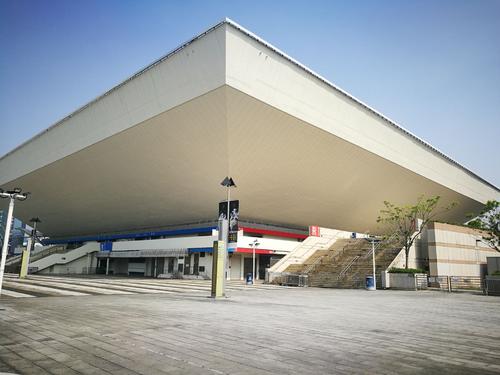
Since the completion of the Hong Kong Coliseum, Hong Kong singers take the holding individual concerts in the “Hong Kong Coliseum” as their main goal. The annual music awards, film awards such as the Hong Kong Film Awards, and beauty contests such as “Miss Hong Kong Campaign” held by major media organizations are also more than that held in Hong Kong’s other Stadiums in number.
Since the opening period, hundreds of stars have come to the Hong Hum to hold concerts.
April 27, 1983, is the date of the birth of the Hong Kong Coliseum. On that day, the governor of Hong Kong, Sir Edward Youde, stood in front of the Hong Kong Coliseum and presided over the opening ceremony. The opening of the coliseum is a major event in Hong Kong and has become the focus of the whole city. The whole process of the opening ceremony was broadcast live on TV. Some media even called the Hong Kong Coliseum “one of the most unique construction projects in the world”.
The Hong Kong Coliseum is unique in appearance, like an inverted pyramid. It is one of the most eye-catching buildings in Hong Kong. The indoor structure of the coliseum does not have a pillar. This architectural feature not only makes the audience’s sight free from any obstacle but also makes full use of the space of 1,600 square meters to set up an auditorium with four sides that can accommodate more than 10,000 people.
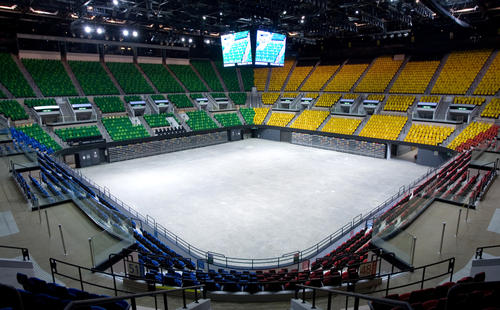
Hong Kong Coliseum is located in the southeast of Yau Ma Tei and Tsim Sha Tsui in Kowloon, adjacent to the Hong Kong Kowloon railway station terminus. Hong Kong people call it “Red Coliseum”. It is a well-known indoor sport and art venue in Hong Kong, as well as a well-known star-making workshop in Hong Kong and even Asia. It is one of the most remarkable buildings in Hong Kong.
There are 12,500 seats in the Hong Kong Coliseum. The huge TV screen hanging in the center of the performance field allows the audience to see the live broadcast of the program from any angle and has the functions of close-up, follow-up, and slow motion. It is an ideal place for holding large-scale sports activities and pop music concerts in Hong Kong.
The facilities of the Hong Kong Coliseum are mainly composed of a large multifunctional indoor performance venue, three activity rooms and one VIP room, which can be used to hold cocktail parties, press conferences, and other activities. Apart from that, the Coliseum has six dressing rooms.
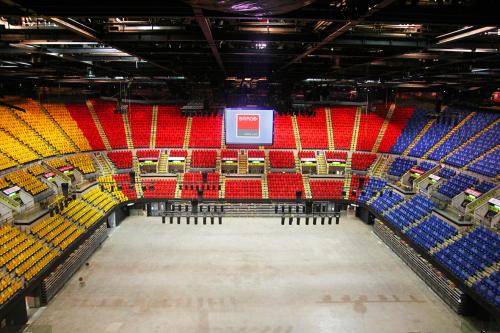
The multifunctional indoor performance venue (stage) has 12,500 seats and a VIP room. According to the requirements of the organizers, the performance venue can be arranged into four-sided platform,or three-sided platform for different types of activities. The concrete floor of the performance venue can also be paved with a wooden floor or rubber mat according to the requirements for activities such as basketball or volleyball matches, or a stage can be built for cultural activities such as concerts.
At the same time, a huge screen is hung in the central part of the venue, which can be used to broadcast the activities in progress in real-time. The display screen of central four-side and full-color projection system suspended in the performance hall can display close-up, slow motion, and replay images, and can also be used as timer, information transmitter, and sports scores display device.
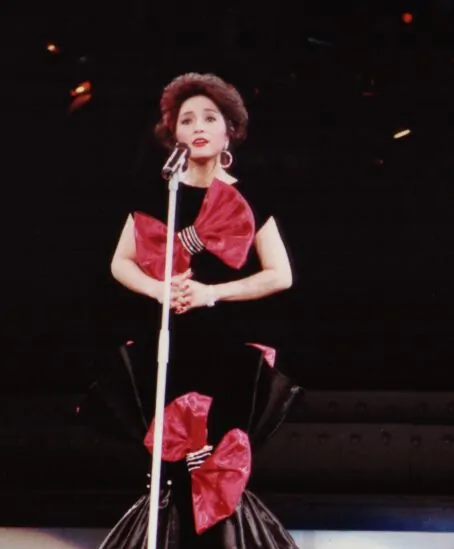
There are four auditoriums in the Hong Kong Coliseum. The auditorium gates are distinguished by five colors: red, blue, green, yellow, and coffee. Generally, the location and color of the seats are printed on the tickets. Most of the sports activities and some concerts are open to all four auditoriums, which is the so-called “four-sided platform”, while some activities only use three auditoriums, and the remaining one is used as the backstage, which is the “three-sided platform”. There are 10,500 fixed seats in the Coliseum. The remaining 2,000 seats are of pull-out type, which can be hidden under the audience seats during some competitions or activities. For some concerts and other activities, temporary seats can be added.
From April 1983 to March 2006, more than 4,300 events were held at the Hong Kong Coliseum, with about 32 million visitors. The Hong Kong Coliseum has always had a very high utilization rate, reaching 96% in 2005-2006.
The Coliseum has a concrete floor with a side length of 43 meters. When different activities are held here, the ground of the venue may be covered with some overlapping ground, such as badminton, basketball, volleyball, and skating, so as to facilitate the activities.
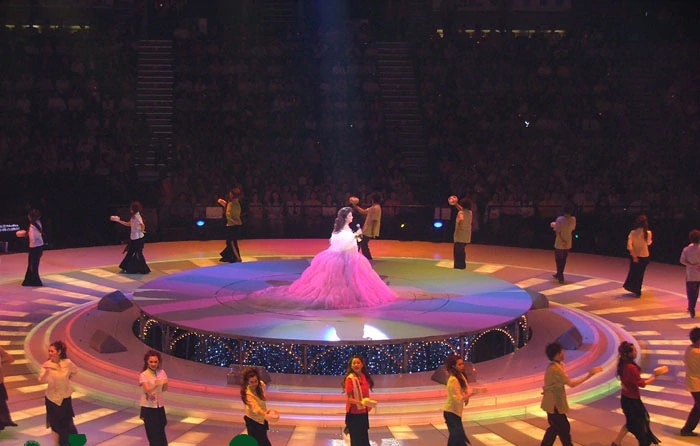
In addition, the floor of the venue can bear the pressure of 1,800 kg / m2, which is not possible for ordinary industrial buildings. The ground’s press compatibility makes it possible to make a new design and decoration of the stage lifting platform and broadcasting system in concerts and similar performances.
Different technical equipment and a four-way colorful TV projection system are also provided in the venue to project the appearance of the performers on stage onto the screen so that the audience at the top of the back row (often referred to as friends at the top of the mountain) can see the appearance of the performers.
The Hong Kong Coliseum has a guest reception room (or VIP room) for the use of venue rental agencies to receive guests or media reporters before the event or during the break. After the East Asian Games improvement project, the reception room covers an area of about 160 square meters and can accommodate about 120 people.
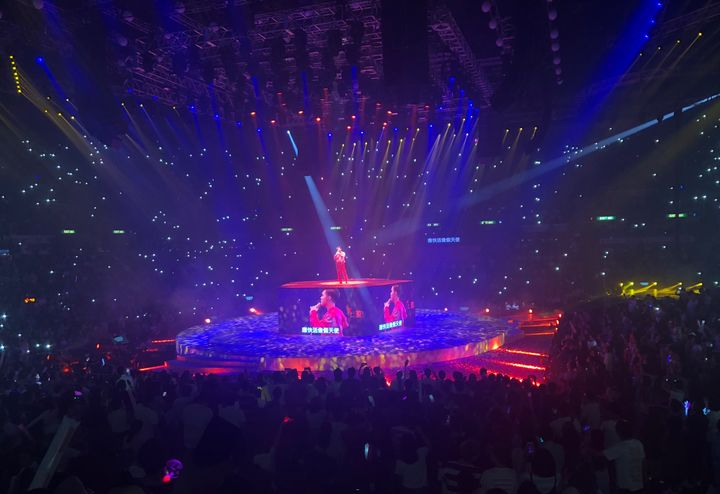
The Coliseum has three activity rooms, covering an area of 33.5 to 187 square meters, which can accommodate 60 people and is equipped with a public address system, telephone socket, and other equipment. There are four makeup rooms and two dressing rooms in the Coliseum. The makeup room covers an area of 16-207 square meters, and the dressing room covers an area of 93 square meters. All of them are equipped with full-length mirrors, telephone sockets, shower facilities, and toilets. The Coliseum is surrounded by an open-air square with an area of 22,000 square meters, which can be used as an auxiliary performance venue for holding outdoor activities such as cocktail parties, exhibitions, and carnivals. The Hong Kong Coliseum has open-air and covered venues for meetings and exhibitions. Its foldable open stage makes the venue an ideal public gathering place.
In 1884, the Hong Kong government began to reclaim the sea at the location of Hung Hom Bay, which was not called Hung Hom Bay at that time. The project was very huge. One day in 1909, a construction worker was drilling a well on the construction site as usual. Suddenly, the color of the water from the well turned out to be vermilion. The contractor who believed in Fengshui(also known as Chinese geomancy, is a pseudoscientific traditional practice originating from ancient China, which claims to use energy forces to harmonize individuals with their surrounding environment)was very nervous and immediately invited Fengshui experts to “diagnose”. After the investigation, the Fengshui experts attributed the vermilion water there to the damage of the dragon vein in Hong Kong caused by earthmoving, and the outflow of well water was dragon blood.
On the other hand, the well water was sent to the laboratory, and the scientific diagnosis showed that the cause of the redness of the well water was due to the presence of iron sulfide and amalgam. Whatever the reason, because of the red-well water, this area has been called Hung Hom ever since. In the 1960s, the Urban Council of Hong Kong planned to build an indoor stadium that met international standards on Hong Kong Island.
However, for a long time, they could not find a suitable site on Hong Kong Island. Later, the Urban Council decided to choose the reclamation area of Hung Hom Bay in Kowloon, which is located on the side of the Hung Hom railway station under construction at that time, next to the Hong Kong Cross Harbour Tunnel running through Hong Kong Island and the Kowloon Peninsula. It is close to a large-scale railway transportation system and subsea tunnel, so it is an ideal site for convenient transportation.
Take the City Bus A20/A21/E21X, or KMB 11X/12P/15X/268B/269B/5A/5C/8/8A/92R and get off at Hung Hom Station.
Chinese: 请带我去香港体育馆。English: Please take me to Hong Kong Coliseum.
If you go to Hong Kong Coliseum from Hong Kong West Kowloon Station, it takes about 8 minutes by taxi and costs about 30 HKD.
If you go to Hong Kong Coliseum from Hong Kong International Airport, it takes about 40 minutes by taxi and costs about 300 HKD.
If you go to Hong Kong Coliseum from Hong Kong Station, it takes about 15 minutes by taxi and costs about 60 yuan.
